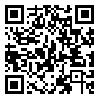Wed, Oct 29, 2025
[Archive]
Volume 18, Issue 3 (2025)
JMED 2025, 18(3): 90-98 |
Back to browse issues page
Ethics code: IR.ZAUMS.REC.1402.235
Download citation:
BibTeX | RIS | EndNote | Medlars | ProCite | Reference Manager | RefWorks
Send citation to:



BibTeX | RIS | EndNote | Medlars | ProCite | Reference Manager | RefWorks
Send citation to:
Arab Borzu Z, Hegazi I, Amiri Moghadam M H, Bakhtiyari M, Hosseini Koukamari P. Translation and psychometric evaluation of a self-regulated learning questionnaire for blended learning among Iranian students. JMED 2025; 18 (3) :90-98
URL: http://edujournal.zums.ac.ir/article-1-2315-en.html
URL: http://edujournal.zums.ac.ir/article-1-2315-en.html
Zahra Arab Borzu1  , Iman Hegazi2
, Iman Hegazi2  , Mohammad Hassan Amiri Moghadam3
, Mohammad Hassan Amiri Moghadam3  , Mahdieh Bakhtiyari3
, Mahdieh Bakhtiyari3  , Parisa Hosseini Koukamari *4
, Parisa Hosseini Koukamari *4 
 , Iman Hegazi2
, Iman Hegazi2  , Mohammad Hassan Amiri Moghadam3
, Mohammad Hassan Amiri Moghadam3  , Mahdieh Bakhtiyari3
, Mahdieh Bakhtiyari3  , Parisa Hosseini Koukamari *4
, Parisa Hosseini Koukamari *4 
1- Department of Epidemiology & Biostatistics, Zahedan University of Medical Sciences, Zahedan, Iran
2- Medical Education Unit, School of Medicine, Western Sydney University, Campbelltown, Australia
3- Student Research Committee, Zahedan University of Medical Sciences, Zahedan, Iran
4- Social Determinants of Health Research Center, Saveh University of Medical Sciences, Saveh, Iran
2- Medical Education Unit, School of Medicine, Western Sydney University, Campbelltown, Australia
3- Student Research Committee, Zahedan University of Medical Sciences, Zahedan, Iran
4- Social Determinants of Health Research Center, Saveh University of Medical Sciences, Saveh, Iran
Abstract: (704 Views)
Background & Objective: The rapid advancement of the Internet and technology has enabled the widespread adoption of blended learning in medical education. However, there is no validated Persian scale to measure self-regulated learning in blended learning among Iranian students. This study aims to fill this gap by translating and validating an existing tool for assessing self-regulated learning in a blended learning environment among Iranian students.
Materials & Methods: The forward-backward method was used to translate the original English questionnaire into Persian. After assessing face and content validity, the Persian version was evaluated for its psychometric properties among 330 students from Zahedan Medical University in Iran. Construct validity was analyzed using Exploratory Factor Analysis (EFA) and Confirmatory Factor Analysis (CFA). To ensure reliability, we calculated the Average Inter-Item Correlation (AIC), Cronbach's alpha, and McDonald's omega. Additionally, convergent and discriminant validity were examined using Average Variance Extracted (AVE), Maximum Shared Variance (MSV), and Fornell and Larcker's criteria.
Results: The findings revealed that the Persian version of the Blended Learning Questionnaire (BLQ) consists of four distinct factors: Accessibility and Guidance (4 items), Social and Contextual (4 items), Delivery of Content (6 items), and Intrinsic and Extrinsic (2 items). Together, these factors accounted for 52.43% of the total variance in the BLQ. The results from the CFA indicated that all goodness-of-fit metrics supported the adequacy of the model. Additionally, the Cronbach's alpha, McDonald's omega, and Composite Reliability (CR) scores were all greater than 0.7, demonstrating strong internal consistency. Moreover, the indices showed acceptable levels of both convergent and discriminant validity for the Persian version of the BLQ.
Conclusion: The study's findings indicated that the Persian version of the BLQ demonstrated acceptable validity and reliability among Iranian students, making it suitable for academic and research purposes in Persian-speaking countries.
Materials & Methods: The forward-backward method was used to translate the original English questionnaire into Persian. After assessing face and content validity, the Persian version was evaluated for its psychometric properties among 330 students from Zahedan Medical University in Iran. Construct validity was analyzed using Exploratory Factor Analysis (EFA) and Confirmatory Factor Analysis (CFA). To ensure reliability, we calculated the Average Inter-Item Correlation (AIC), Cronbach's alpha, and McDonald's omega. Additionally, convergent and discriminant validity were examined using Average Variance Extracted (AVE), Maximum Shared Variance (MSV), and Fornell and Larcker's criteria.
Results: The findings revealed that the Persian version of the Blended Learning Questionnaire (BLQ) consists of four distinct factors: Accessibility and Guidance (4 items), Social and Contextual (4 items), Delivery of Content (6 items), and Intrinsic and Extrinsic (2 items). Together, these factors accounted for 52.43% of the total variance in the BLQ. The results from the CFA indicated that all goodness-of-fit metrics supported the adequacy of the model. Additionally, the Cronbach's alpha, McDonald's omega, and Composite Reliability (CR) scores were all greater than 0.7, demonstrating strong internal consistency. Moreover, the indices showed acceptable levels of both convergent and discriminant validity for the Persian version of the BLQ.
Conclusion: The study's findings indicated that the Persian version of the BLQ demonstrated acceptable validity and reliability among Iranian students, making it suitable for academic and research purposes in Persian-speaking countries.
Article Type : Orginal Research |
Subject:
Medical Education
Received: 2024/10/26 | Accepted: 2025/07/14 | Published: 2025/10/1
Received: 2024/10/26 | Accepted: 2025/07/14 | Published: 2025/10/1
| Rights and permissions | |
 |
This work is licensed under a Creative Commons Attribution-NonCommercial 4.0 International License. |


